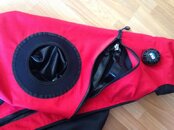Hi, this is Bruce from SEASOFT SCUBA. I think we were the first company to use Ti ZIP in North America in a suit and I am going to share all I know about Ti Zip zippers. We started testing the SUPERSEAL in 2004-2005 and offered them as an option in 2005. At first we got a few suits where the zipper split (it opened up after it was closed), very frustrating! I was told by Ti Zip that they were correcting this and later on this virtually disappeared.
The cool part about the SUPERSEAL is that you can open and close it yourself because the teeth are small and there is a rubber dam on both sides of the teeth and it doesn't catch the undergarment very easily. This is still the zipper we sell in our drysuits and our customers love it.
In 2010 we had an issue with a batch of suits, the glue was not sticking to the backing that the SUPERSEAL was attached to. Remember this was new to all of us - so what glues to use? how to install it? etc. it was pretty new. But we figured this out, fixed all the suits, figured out the right protocol and moved on.
In 2008 or 2009 we started offering a line of semi-dry wetsuits with a Ti Zip that was similar to the SUPERSEAL called the WATERSEAL. It was open at one end so you could open up the wetsuit.
A couple or so years ago we were offered the MASTERSEAL which is what a lot of companies are now using. It has big plastic teeth and is less expensive than a brass zipper BUT a tooth knocked out is still a tooth knocked out. We stayed with the SUPERSEAL even though it is more expensive.
Here is how you take care of a Ti Zip and don't let anyone else tell you different. We get suits back for repairs and zippers to be replaced because people listen to those who don't know or who are guessing based on the care of a brass zipper.
1. Lubricate with high quality silicone grease. Not a silicone grease laden with fillers.
2. Your zipper must be allowed to dry in hot, humid climates. In rare cases a bacteria will destroy the rubber if it is left wet for day after day after day in a hot humid place.
3. It is OK to leave it open or closed for storage but we recommend open to allow air to circulate into the suit.
4. Lubricate every other dive unless it has not been used for more than two weeks. Then lubricate again.
5. Lubricate by dipping your clean fingers in silicone grease and sliding grease across the teeth. No need for excess grease but not a cosmetic coating either. NOW open and close the zipper at least 6 times to distribute the grease.
6. Pay extra attention to the ends!
7. With the zipper closed run your grease finger along the edge of the zipper coating any rubber parts until they have a generous but not excessive coating. Allow this grease to be absorbed.
8. With the zipper closed reach through the neck and do the same to the inside of the zipper.
9. After diving always rinse the zipper and inspect the zipper for damage, debris etc.
10. It is crucial to keep the zipper out of direct sunlight and any heat source as these can both damage the zipper (and your suit).
After doing more than 5,000 drysuit dives I can confidently say that I prefer the Ti Zip over any brass zipper for a host of reasons - lighter, tougher, less expensive to replace, self-closing, and more.
If you have any other questions, feel free to ask.
Bruce
SEASOFT SCUBA





